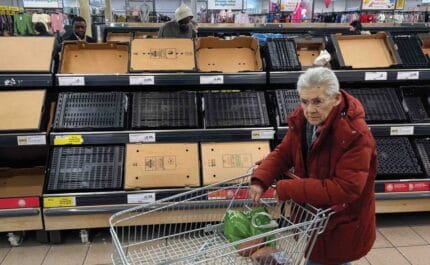The long walk home
India's Covid-19 lockdown sparked the biggest mass exodus since Partition, with millions of internal migrant workers forced to trudge hundreds of miles to their home villages in dangerous conditions. We charted the impact of the lockdown on some of the world’s most vulnerable people, and asked what their experience tells us about life in Modi’s India
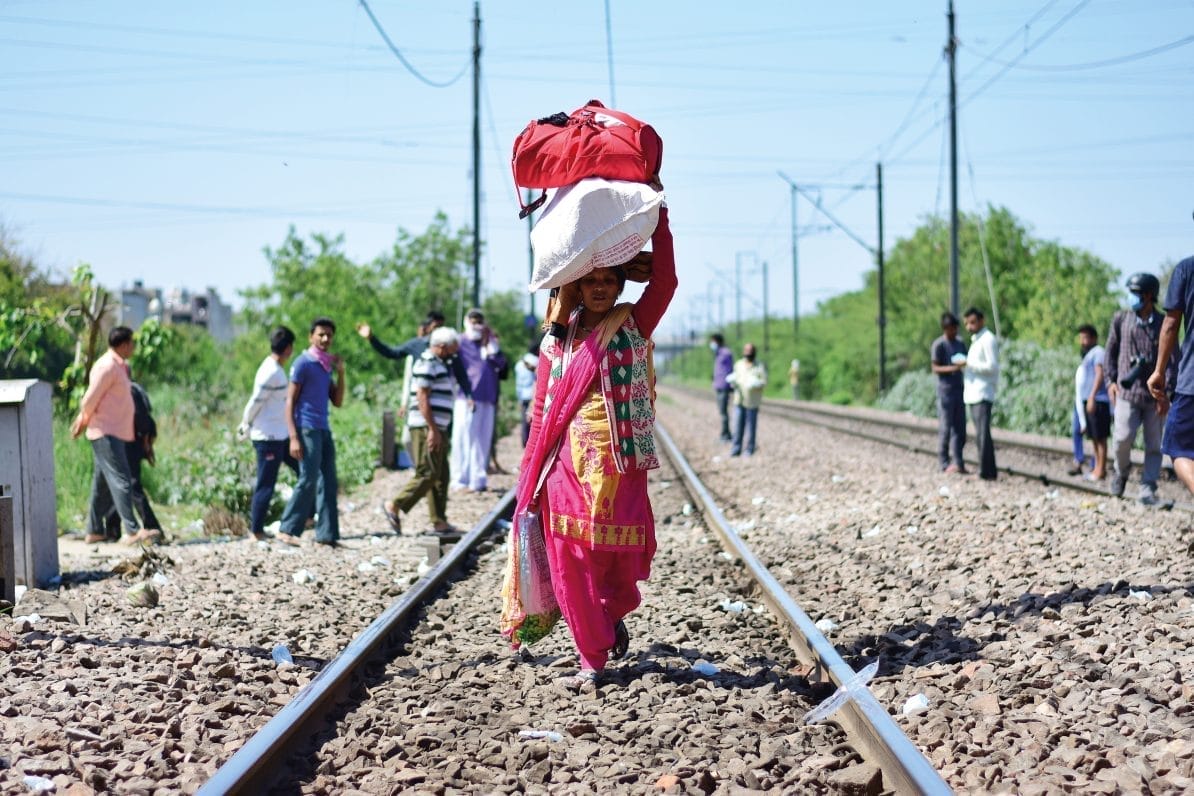
A woman carrying her possessions leaves a Delhi train station to walk to her home village. Photo: Manish Rajput/SOPA Images/LightRocket via Getty Images
2nd June 2020 (Taken from: #39)
At 8pm on the night of 24th March 2020, Indian prime minister Narendra Modi was giving a national broadcast about the coronavirus pandemic. At that point, India had recorded 564 cases of Covid-19 and ten deaths. “The entire country shall go under complete lockdown,” he said. “To save India, to save its every citizen, from midnight tonight a full ban is being imposed on people stepping out of their homes.”
India’s population of 1.3 billion was given four hours’ notice of the imposition of one of the strictest lockdowns in the world. Minutes after Modi’s speech, chaos set in. The absence of details about essential goods and services meant that there was suddenly a deluge of people and cars on the roads, queues at pharmacies and cash machines and a palpable wave of panic. In the more affluent neighbourhoods of the capital, Delhi, the shelves of off-licences were emptied and in the busy lanes of East Delhi, crowds of people jostled in grocery stores trying to buy flour, milk and oil.
An hour’s drive away in Faridabad, police patrolled the streets in Jeeps, blaring out warnings about the 21-day lockdown and the imposition of Section 144 of the Indian Penal Code, which bans any congregation of more than four people in a public place. In Faridabad’s urban slums, it would be almost impossible to adhere to the government’s orders. The city is the eighth fastest growing in the world and its rapid urbanisation has meant an influx of workers from poorer states, who perform manual labour on construction sites for as little as 200 rupees (£2) per day. Living in densely packed tenements or roadside huts, and sharing toilets with up to 100 other people, these daily wage labourers had no way to maintain social distancing – and without a source of income they were at risk of starvation.
This was Vimla Devi’s main concern when India’s lockdown was announced. Living in a tenement near Ankhir Chowk, a busy intersection in Faridabad, she didn’t know how her family would survive the next 21 days. Like many other interstate migrant workers in India, she and her husband had travelled from their home in the northern Indian state of Uttar Pradesh to find work in Faridabad. On good days, construction labour would earn the couple 400 rupees (£4). With this, they would feed their son and daughter, pay rent and loan installments and send money to their parents back in their home village. But with Modi’s announcement, construction sites halted all work and the subcontractor had nothing to offer Devi and her husband. “We spent those days worrying about where we would be able to get our next meal, when we would be able to eat,” she says. “Work had totally stopped and we didn’t have any money. So we left.”
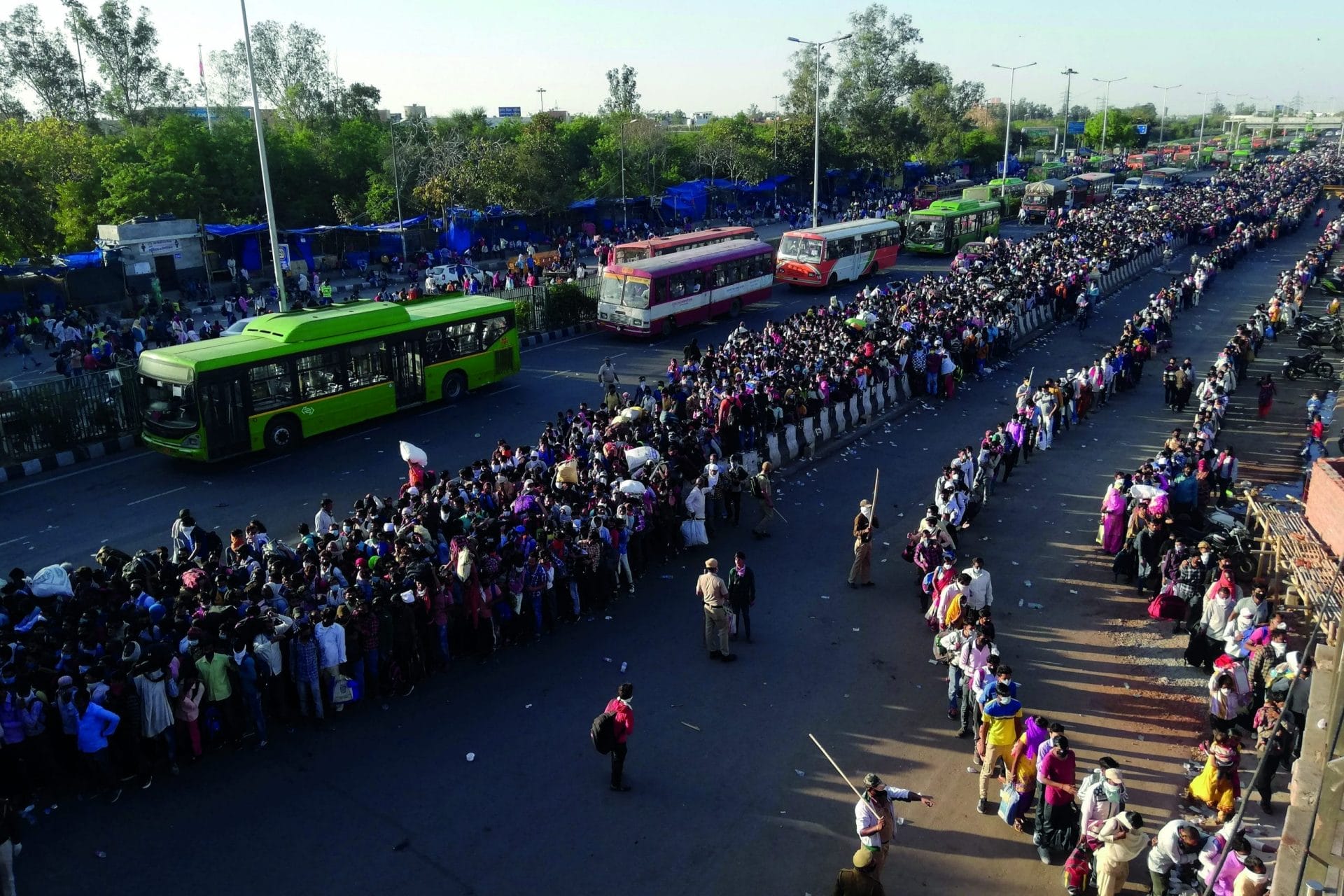
Migrant workers stand in line at the Anand Vihar bus station in Delhi in an attempt to get transportation out of the city. Photo: BHUVAN BAGGA/AFP via Getty Images
Returning to their home states was the only option left to many of India’s estimated 65 million interstate migrant workers, a figure that doesn’t include their family members. Working at construction sites, in mines, factories, hotels, restaurants and as domestic help in people’s homes, they were suddenly out of the jobs for which they had migrated to cities. Although interstate travel was against the lockdown regulations, by the end of March many state governments were scrambling to organise transport for a wave of migrants crowding bus and train stations.
Pictures went viral on social media of crowds of internal migrants wearing masks and carrying large bundles of possessions on their heads as they attempted to get back home. Meanwhile Bollywood stars, suddenly finding themselves without domestic help, posted comic videos of themselves cleaning their own dishes. Government minister Prakash Javadekar sparked derision and comparisons with Marie Antoinette when he tweeted a photo of himself relaxing during the early days of lockdown while watching Hindu epic Ramayana on TV, in stark contrast to the desperation on the streets.
We didn’t have any food or water. When we ran out of money we just went hungry. But we kept walking”
On 28th March, around 15,000 people gathered at Delhi’s Anand Vihar bus station hoping to get home. The Uttar Pradesh government had promised to arrange a thousand buses to ferry stranded migrants across the state border, but only 70 were reported to have turned up. Within minutes they were packed and people were scaling the sides to grab a space on top. To deal with the crowds and potential stampede, the police resorted to violence, beating migrants with batons for violating the lockdown. The next morning, the bus station had been barricaded. With no other mode of transport available and nowhere else to go, thousands packed whatever possessions they could carry, and began their long walk home.
From her village near Jhansi in Uttar Pradesh, Devi tells me over the phone that she walked at least 300 miles to get there. “We didn’t have any food or water. When we ran out of money, we just went hungry. But we kept walking,” she says. At night, she tried to get her 17-year-old daughter and ten-year-old son to sleep for a few hours by the side of the road. Sleep didn’t come easily, though, and they would often continue to walk in the dark. “While we were walking, I kept thinking about what we would do once we got home,” Devi tells me. “What work would we do? How would we feed our children?”
Over the eight days of their journey, Devi kept hoping for help. At a checkpoint in Mathura, 75 miles along the way, authorities told her that they would arrange for buses to take her and her fellow migrants home. As they waited, the crowd grew. She says that at least 5,000 people eventually assembled but that even after hours of waiting no buses came. Someone told them that the bus fare would be 600 rupees (£6) if they did manage to get on board. Truck drivers transporting cargo offered them a lift in the back for 2,000 rupees (£20). “But where would we have got that kind of money?” Devi asks me. “If we had that, why would we be walking?” With swollen, blistered feet, in 35-degree heat, she realised they just had to keep going.
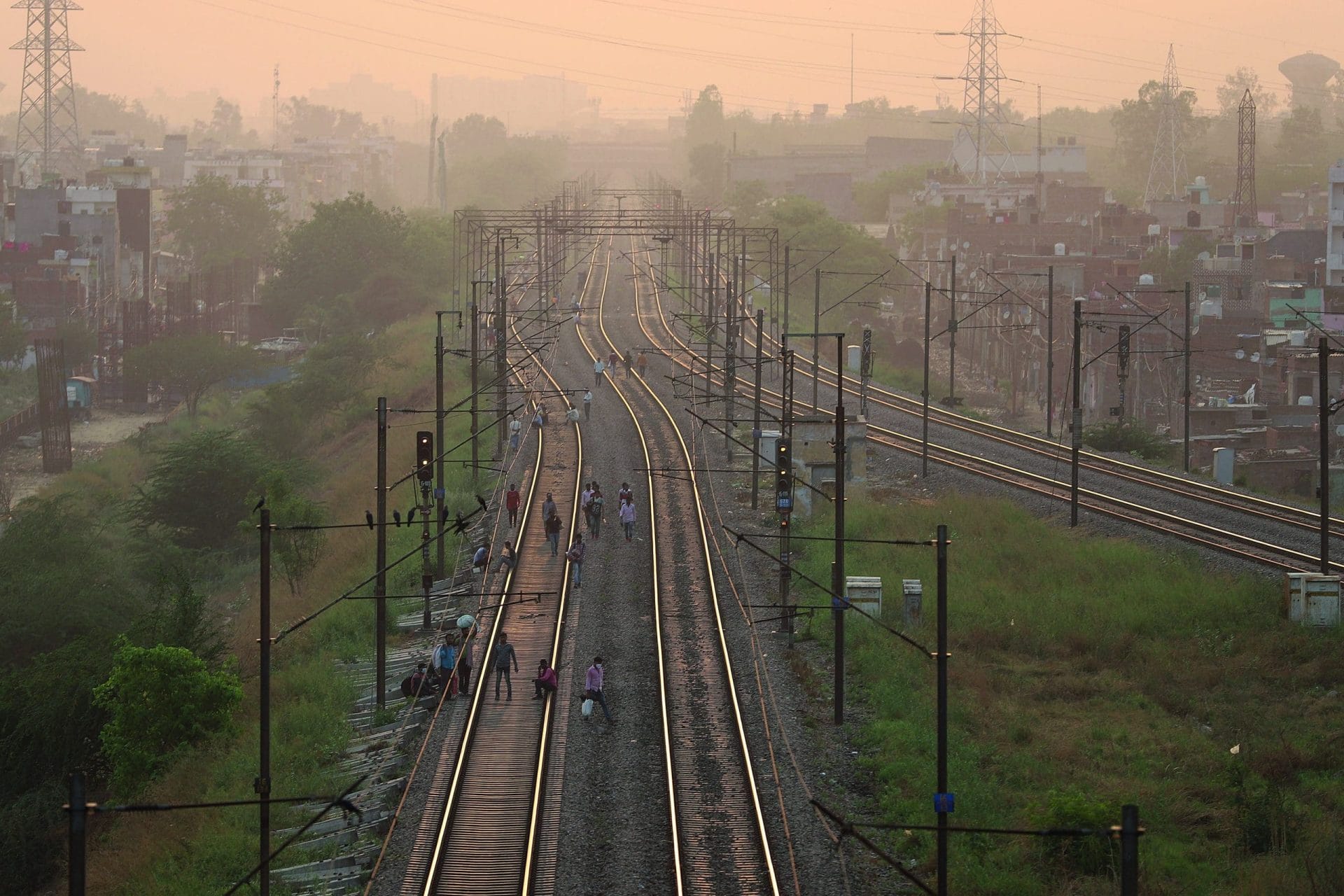
Migrant workers walk alongside a railway track near Ghaziabad, Uttar Pradesh, on 13th May 2020. Photo: Amarjeet Kumar Singh/SOPA Images/LightRocket via Getty Images)
In the weeks that followed, cities across India saw an estimated 30 million migrants-turned-internal-refugees head home, many walking along the now-empty state highways. Such an exodus has not been seen since the Partition of India in 1947.
In order to limit the potential spread of disease caused by mass movement during a pandemic, relief camps were set up for those who were detained by the police mid-journey, while others were forced into homeless shelters. By early April, hundreds of workers stranded in Ahmedabad and Surat, major commercial centres in Gujarat, began protesting for their right to return home, destroying vegetable carts and vandalising property. Near Delhi’s Kashmere Gate, migrant labourers allegedly set fire to three homeless shelters after repeated altercations with the staff over food and the death of a migrant.
Some state governments like communist-led Kerala were able to placate the workers, reassuring them that the state would provide adequate food and shelter and implementing measures to address their grievances. However, many other states didn’t, resulting in violent clashes between migrants and police. When the central government announced three further extensions to the initial lockdown, on 14th April, 1st May and 17th May, workers gathered on the streets in major cities across the country, blocking highways and crowding into train stations, demanding transport home.
With no other recourse, migrants were regularly dying of starvation and dehydration as they walked along the roads and railways. In the early hours of 8th May, 16 workers from Maharashtra, who were exhausted from following the railway tracks north to get to their home in Madhya Pradesh, fell asleep only to be run over and killed by a freight train.
A week later, two trucks on which workers had hitched a ride crashed into each other in Uttar Pradesh, killing 27. In a video that went viral, a child tugged at the shroud covering his mother’s body as it lay on the floor of a railway platform. Many NGOs tried to provide relief to workers, setting up helplines and creating interstate networks of social workers who could assist people with food and transport. But the tide of migrants, struggling onwards under the blazing sun, continued unabated.
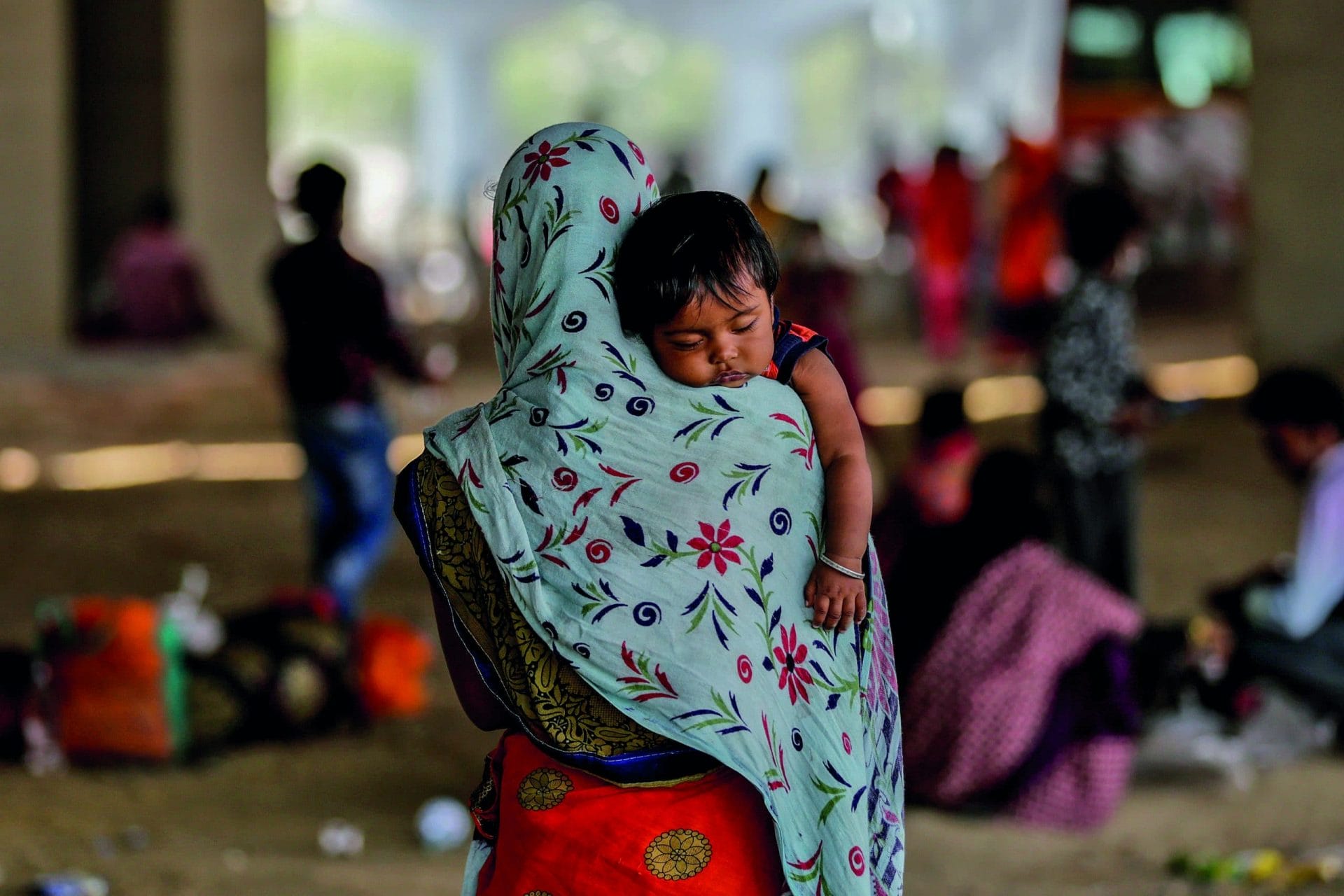
A woman and her tired daughter stop for a rest under a Delhi flyover on 18th May 2020. Photo by Amarjeet Kumar Singh/SOPA Images/LightRocket via Getty Images
Kusum Ahriwal finds it difficult to get the timeline of events straight in her mind. As I ask her about her journey, she keeps circling back to Gwalior in her home state of Madhya Pradesh, the place where her husband died. Before the lockdown, the 42-year-old was a domestic worker, sweeping and mopping other people’s homes in Bawal, a city in the state of Haryana. Her husband was a construction labourer and together they earned around 4,000 rupees (£40) a month. They lived in a makeshift encampment of huts, along with many others from their village, Dhamna.
When 20 of her neighbours decided to leave Bawal three days into the lockdown, she and her husband were persuaded to join them. Together they planned on walking or hitchhiking the 270 miles home. “We all left together. We all reached Gwalior together,” she tells me, recounting the events that led up to that fatal moment.
He was hit on the head from behind and he died right there. We were in Gwalior, nobody was there to help”
Ahriwal had been walking for four days at that point. She tells me they had no food and almost no water left. The group hadn’t been able to find any help along the way. “We didn’t stop though, we just continued to walk. All I could think about was wanting to get home,” she says. The couple had left their two teenage sons back in the village, and Ahriwal ached to see them again – she says that this alone kept her walking through the hunger, thirst and exhaustion. Reaching the historic city of Gwalior meant that the group had finally crossed into their home state.
They were 90 miles away from their destination when a car speeding down the highway caught them off guard and Ahriwal’s husband was hit. Ahriwal does not remember how many hours it took before the police showed up or the ambulance that drove her husband’s body to the nearest medical centre, to be pronounced dead on arrival. She repeats the details to me. “He died right there. He was hit on the head from behind and he died right there. We were in Gwalior, nobody was there to help.” The ambulance driver organised transport for Ahriwal to take her husband’s body back to their village. It was just a three-hour drive away. “We performed his last rites and then cremated him,” she tells me. “We were married for 25 years.”
Migrant workers have always lived precariously, in the shadows of the cities they helped to build. But the pandemic caused them to come into clear view, and the crisis that has always existed in India was finally revealed.
Over 80 percent of those working in India do not have an employment contract, according to a 2018 report by the International Labour Organization. Many of these workers are interstate migrants. But the story of migration in India is not one of people leaving their villages and towns to fulfill big dreams in the city. Instead, it is a desperate last resort for people whose lives and livelihoods are under threat. Most who leave are subsistence farmers who can no longer afford basic necessities. They often have few assets and little education, and their difficulties are compounded by marginalised caste identities.
Since there is no centralised social security system in India, migrants forego entitlements when they cross state lines. Schemes like the Public Distribution System (PDS) provide food rations at highly subsidised rates, but unless you have a ration card registered in the state in which you are working you cannot make use of it. In cities, migrants tend to have informal rent agreements, living in makeshift slums or illegally constructed housing. While they remain in such set-ups, they cannot show any official proof of residence. With no electricity or water bills in their name, it is difficult to open a bank account.
The construction sector employs 37 percent of migrant workers and contributes nine percent of the country’s GDP: along with factories its need for workers draws in around nine million people from rural areas every year. While there are laws in place to protect workers’ rights, they are difficult to enforce. Workers often don’t even know who to hold accountable, having been hired by subcontractors paid to recruit labour for other companies.
Without official proof of employment or residence, migrant workers are rendered invisible, unable to make any claim on cities in which they may have been living for decades. When the lockdown was announced, it only took a few days before their informal agreements collapsed and many chose an uncertain journey back home – despite the threat of violence, starvation and death – rather than the certainty of neglect in the cities.
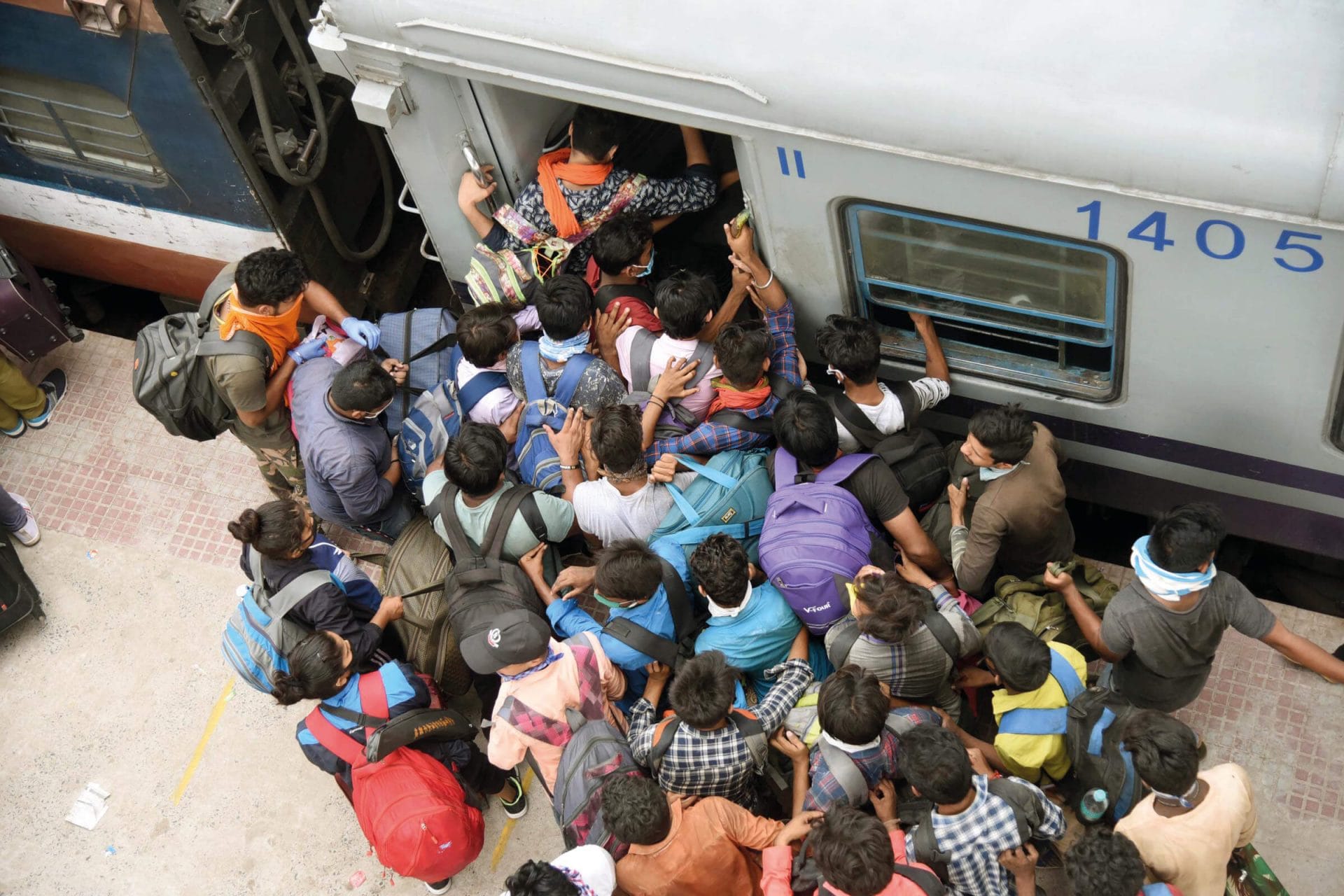
Migrant workers rush towards a Shramik train service arranged for them in Patna, Bihar, on 20th May 2020. Photo: Santosh Kumar/Hindustan Times via Getty Images)
Ravi Srivastava recounts the government’s response to the migrant crisis with an air of resignation. Previously a professor of economics, he is now the honorary director of the Centre for Employment Studies at Delhi’s Institute for Human Development. “All of us who worked in the sector knew about the scale of migration and the limited reach of social protections,” he says. “But several weeks into the lockdown, the government had still made no effort to find out the dimensions and nature of the crisis. Instead, they approached it as a law-and-order problem, locking up migrants in their own homes or makeshift shelters.”
Two days after Modi’s address, finance minister Nirmala Sitharaman announced a £19 billion relief package, which included an increase in food rations and direct cash transfers for senior citizens, farmers and daily wage labourers. According to a report published by the Stranded Workers Action Network (SWAN) on 1st May, 97 percent of the 10,383 migrants surveyed had not yet received any cash relief from the government. In late August, Devi tells me she’s still waiting on the cash transfer, as is everyone in her village.
We got calls from people saying ‘There’s a corpse lying here, he died from starvation. My children are seeing this. Please help us'”
The government initially maintained that the exodus of workers was due to “fake news that the lockdown would continue for more than three months”. In his statement to the supreme court on 31st March, solicitor general Tushar Mehta insisted that “there is no person walking on the roads in an attempt to reach his/her home towns/villages.”
However, a month into the lockdown, when the scale of the migrant crisis was impossible to ignore, the government introduced special ‘Shramik’ (‘Labour’) trains to transport workers home. On 6th June the chairman of the railway board, Vinod Kumar Yadav, stated that these special trains had brought 5.8 million workers back to their home states. But running them proved to be a logistical nightmare, not least because the coordination was left to state governments, with departure and destination states having to make joint requests for agreed-upon numbers of migrants to travel at set times.
Passengers, meanwhile, had to fill out online forms, wait for weeks for a confirmation, pay for their own medical screenings, report to local police stations and fight their way onto the overcrowded trains. The journeys often included ten-hour-long delays with no food or water. There were 80 reported deaths on Shramik trains, the youngest of which was of a four-year-old boy, the son of a migrant worker. The railway ministry claimed that every death was due to pre-existing illnesses.
“Interstate migration and interstate quarantine are central-government subjects,” says Srivastava. “And yet this government didn’t take any proactive measures in terms of coordinating the efforts between source and destination states, who were reluctant to send and receive migrants anyway.” He believes that Shramik trains were mismanaged. “It was a bizarre mess. The only thing I can say is that it had to be, in part, an intentional mess. After all, it’s not that the Indian government didn’t have the capacity to handle this better… Governments worry about what will have a political cost. In this case, they didn’t really believe that dealing with migrants in this way would entail any political cost for them.” With the benefit of five months of hindsight, he adds, “In a sense, their calculations were correct.”
As migrants started returning to rural villages, primary schools were converted to quarantine centres to hold people for two weeks until it was safe for them to return home. But many migrants mistrusted the authorities and were reluctant to be detained again. A fieldworker for Jan Sahas, an NGO working with migrant communities, explains that many people tried to bypass the checkpoints, hiding in fields and sneaking into their houses at night.
Rural primary health centres, meanwhile, were prioritising their scarce resources on Covid-19 patients, sometimes at the cost of others. “We got calls from people saying, ‘There’s a corpse lying here, he died from starvation. My children are seeing this. Please help us,’” says Bahadur Arwal, a Jan Sahas helpline operator. The calls were unlike anything he ever had known. From the end of March until May, Jan Sahas was receiving up to 900 calls per day, and its team of six was increased to 15 to field them. Arwal tells me that he takes a lot of pride in his work, but that the past few months have made him terribly sad. “To see my brothers and sisters brought to such a state of desperation… It keeps me up at night.”
In the villages that the millions of migrants had risked death to reach, there was little hope of employment. In Sijari Khurd, where Vimla Devi lives, her children asked her why she and her husband weren’t leaving the house every day to earn money. Although they found some construction work, it was halted after a week. Devi’s father-in-law owns two cows and a small patch of land where they grow what they can, and the family survives on this along with some government-issued food rations. But as Devi says, “Nobody can live on five kilos of flour [a month]. We have to find some work otherwise we won’t eat.”
In Ahriwal’s village the work in the fields stopped, and there was no one who could afford to pay her to do the domestic jobs she used to do in Haryana. Since March, she says, she has stayed in her mother’s house with nothing to do. “Every day I am filled with worry,” she tells me. “How will I put my children through school? How will we get food? Corona will go away, but hunger won’t.”
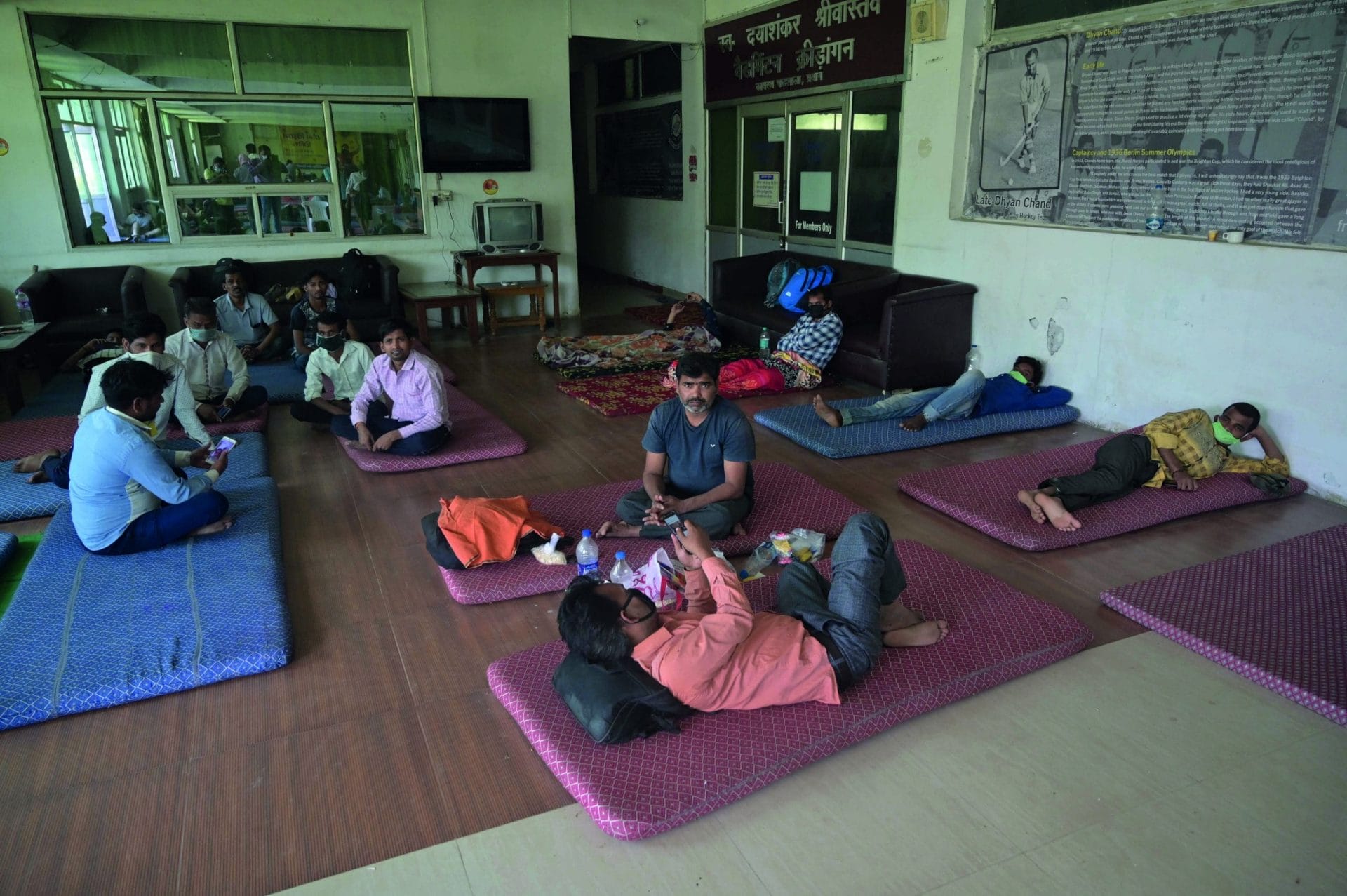
A group of workers rest at a quarantine centre in Prayagraj, Uttar Pradesh, on 31st March 2020. Photo by Prabhat Kumar Verma/Pacific Press/LightRocket via Getty Images
In early 2020, while Covid-19 was spreading in the Chinese city of Wuhan, protests were taking place across India over a citizenship law passed in December. The ruling grants a pathway to citizenship to undocumented migrants from Afghanistan, Bangladesh and Pakistan, but only if they are not Muslim.
On 23rd February, protesters at a sit-in on a main road in northeast Delhi were attacked by a Hindu nationalist mob armed with pistols, swords and saffron flags, a symbol of the Hindu right. Over the next ten days, rioters set fire to mosques, schools, homes and businesses in Muslim neighbourhoods and clashes between the communities resulted in 53 people dying, most of them Muslims.
With tensions running high, the fearmongering and rumours swirling around Covid-19 quickly turned into widespread discrimination against Muslims, India’s largest religious minority. A religious gathering held by the Delhi chapter of Islamic missionary organisation the Tablighi Jamaat, was identified as a coronavirus ‘super-spreader event’. And although the event took place between the 1st and 20th March, which was before the lockdown announcement, several state leaders, including Uttar Pradesh’s chief minister Yogi Adityanath, blamed the Tablighi Jamaat for spreading the virus on purpose. Adityanath himself would attend a Hindu prayer gathering at a temple with 20 other people, just 12 hours after the prime minister’s lockdown announcement. Videos that claimed to depict Muslims coughing or sneezing on people were soon being shared across social media platforms, with the implication that Muslims were involved in bioterrorism. By 31st March #CoronaJihad was trending on social media sites in India.
“We were told, ‘Corona is being spread by Muslims like you,’ and nobody wanted to help us,” says Raunak Parveen. The 24-year-old had been living with her husband in Jalaun, Uttar Pradesh, for five years. She worked as a tutor for children and helped her husband with his tailoring work on the side. But from March onwards, nobody wanted to be near them. Parents of the children she used to teach claimed that she would pass the virus on to them, and refused to pay for classes they had already taken. “When we tried to get vegetables, even with a mask and gloves, we weren’t allowed in any shops because they said we would bring corona with us,” she says. “What did they want us to do? Starve to death?”
Parveen was wary of following in the footsteps of other migrants and attempting the 440-mile journey home to her village of Hazaribagh in Jharkhand. “We were scared of getting this disease,” she says, “especially because everyone thought that Muslims were to blame. They would have caught us and taken us away. How would we get back to our village then?” Instead the couple stayed in their one-room home, begging the food rations store for some extra grain, which they would sneak out in the middle of the night to bring back. By the start of Ramadan in late April, they had run out of money. “Our landlord was asking for rent. Nobody was giving us any work or rations; they didn’t want anything to do with us.” An NGO worker finally arranged for the couple to take a train to a town close to their village in early June. From there, a taxi driver charged them 3,000 rupees (£30) to take them home. They had to borrow the money from neighbours once they arrived.
We were told ‘Corona is being spread by Muslims like you,’ and nobody wanted to help us”
The wave of bigotry and pandemic-induced religious anxiety meant that many Muslims were targeted in towns and cities. They were beaten up by mobs and discriminated against by hospital officials who were reluctant to admit them for unrelated injuries or illnesses in case they had Covid-19. The prime minister, however, had other priorities than calming sectarian tensions. On 5th August, Modi attended a religious ceremony to mark the start of construction of a Hindu temple in Ayodhya. Also present were Hindu nationalists, including the leader of Hindu supremacist organisation the Rashtriya Swayamsevak Sangh. The moment signified the completion of an electoral promise to begin building a temple on the spot where a 16th-century mosque was demolished by a mob of Hindu nationalists in 1992.

Indian Muslims argue with police after they were removed from a Delhi protest site on March 24, 2020. Photo: Yawar Nazir/Getty Images
Rajendran Narayanan, an economics professor at Azim Premji University in Bengaluru, believes that the government is using religion to demonise certain groups and mollify others. He fears that Indians are now operating on a politics of schadenfreude, in which they measure their prosperity in terms of others’ distress. As long as minorities are in a worse position, he claims, people won’t agitate for social and structural changes. “They want to make a spectacle out of these religious performances,” says Narayanan of the Modi administration. “Distraction is their method of governance.”
By the beginning of August India had 1.9 million coronavirus cases, making it the third worst hit country after the United States and Brazil, and millions of people had lost their jobs. Most Indian cities, however, looked like they had gone back to normal. Cars and buses were back on the streets causing traffic jams, the monsoon floods struck once again and people began stepping out of their homes. On 15th August, the country’s 74th Independence Day, Modi addressed the nation once again, this time from the ramparts of the capital’s historic Red Fort. In his speech he reiterated his goal of an ‘Atmanirbhar Bharat’ – a self-reliant India. Back in her village, Parveen echoes a similar thought. “I want to tell the government that we don’t want to be handed money, we want to work. Give us work,” she says.
But as Indian factories and companies resume business, state governments are relaxing labour laws, increasing work days from eight to 12 hours and reducing workers’ wages and negotiating ability with the stated aim of kickstarting the economy. When ten out of the country’s 12 central trade unions held a nationwide protest against the government’s “anti-people policies” in August, 100 workers were arrested for holding a protest without a permit and violating social distancing guidelines. The future for migrant workers looks bleak.
While the Indian government may have sought to curb the fallout of the coronavirus pandemic, it sparked a humanitarian crisis that would deepen socio-economic fault lines even further. “Hunger is going to be a huge issue, and the next crisis we’re going to face is a crisis of nutrition,” predicts Narayanan. “Whenever there is scarcity, it’s the vulnerable communities that are most affected. So we’ll see Dalit [‘untouchable’ lower caste] kids, Adivasi [tribal] kids and Muslims in poorer neighbourhoods being the most affected.” He foresees that this will cause a domino effect, disrupting education and employment rates as well.
By late August, Vimla Devi and her family’s need to earn money for food, as well as to pay monthly instalments on their loan, led them to try to get back to the city. “We know the disease is spreading, but we can’t afford to worry about it,” says Devi. “We have no other choices left.” They are currently trying to save the 2,000 rupees (£20) they will need to hitch a ride with a truck back to Faridabad.
For Ahriwal, returning to the city without her husband is not an option. As a widow, she wouldn’t feel safe living in the city alone. She has now received 400,000 rupees (£4,000) from the state government in compensation for her husband’s death, and has chosen to stay with her mother in Madhya Pradesh. When I speak to her, she sounds listless. She tells me that she trusts the government, that it is doing what it can.
The central government admitted on 14th September that it has no data on the number of jobs that were lost or the migrant workers who died during the lockdown. But even without clear figures, the images of men, women and children left unmoored by the pandemic and by a country that overlooked them will be difficult to forget. Narayanan sees their long and dangerous walk home as an expression of resilience. “It’s as if they were saying, ‘You can’t stop me. You won’t give me trains, so I’ll walk,’” says Naryanan. “They were treated with indignity, but their response was a kind of resistance.”
Slow Journalism in your inbox, plus infographics, offers and more: sign up for the free DG newsletter. Sign me up
Thanks for signing up.
